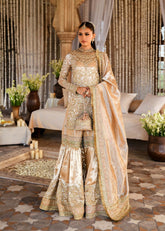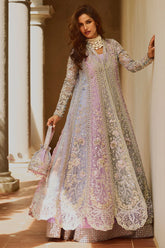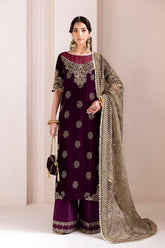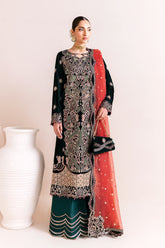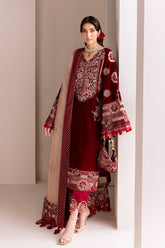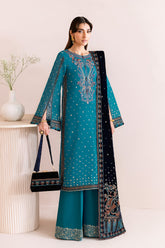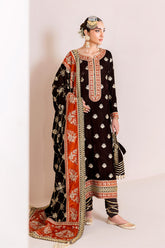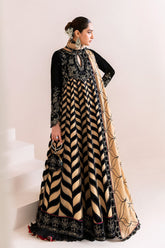Block Prints, Chikankari, and Other Heritage Textiles in Eastern Outfits
Eastern attire, known for its elegance and intricate craftsmanship, has long been revered for its ability to blend traditional artistry with contemporary design. Among the key components of this rich textile tradition are techniques like block printing and chikankari, which have transcended time and place, becoming symbols of cultural heritage. These methods of decoration not only tell the story of the South Asia’s rich history but also showcase the creativity and dexterity of artisans. Let’s dive into the world of block prints, chikankari, and other heritage textiles that continue to play a significant role in eastern fashion.
The Timeless Charm of Block Prints:
Block printing is one of the oldest and most celebrated textile traditions in South Asia. It involves using carved wooden blocks to stamp intricate patterns onto fabric, resulting in vibrant designs. Originating from centuries-old methods, this technique reflects the cultural exchange between different communities. The process is as much about artistry as it is about precision—each print is meticulously applied by hand, creating unique patterns on fabrics that are as varied as they are beautiful.
The most common fabric used for block printing is cotton, which is ideal for absorbing natural dyes. The printing process typically begins with selecting the right fabric, followed by applying a base color using a wooden block. This is done repeatedly to build up the design. Various regions are known for their distinctive block print styles. For instance, some are renowned for their floral motifs, while others focus on geometric or paisley patterns. Each motif tells a different story, whether inspired by nature, mythology, or the everyday lives of people. Drawing inspiration from collections like Nilofer Shahid Lawn, these designs seamlessly blend traditional craftsmanship with contemporary aesthetics.
One of the reasons block prints are so enduring is their versatility. The technique can be applied to various types of clothing, from sarees to kurtas, and even accessories like scarves and stoles. Over time, designers have adapted block prints to suit contemporary tastes, often using modern color palettes while still preserving the traditional motifs.
Chikankari: A Stitching Tradition
Chikankari, often referred to as "shadow work," is an embroidery technique that has roots in the South Asia's royal history. This intricate hand-embroidery method involves the use of needle and thread to create elaborate floral and geometric patterns on fabric. Traditionally, chikankari was done on fine cotton or muslin, which allowed the delicate stitches to shine. Modern adaptations, as seen in Kanwal Malik clothing, incorporate chikankari into luxurious fabrics and contemporary designs, bridging the gap between traditional craftsmanship and modern fashion sensibilities.
The beauty of chikankari lies in its subtlety. Unlike some other forms of embroidery that use bold colors and thick threads, chikankari is known for its delicate, almost ethereal appearance. The embroidery is typically done with white thread on light-colored fabrics, but today, artisans have expanded the use of vibrant threads to create colorful, eye-catching designs.
Chikankari's origins are closely tied to the South Asia’s royal courts, where it was often a mark of wealth and sophistication. Over time, this embroidery style became more accessible, finding its way into the wardrobes of everyday people. Its intricate beauty and timeless appeal make it a favorite choice for both formal and casual wear, with designs ranging from floral to geometric patterns.
Much like block printing, chikankari has seen modern reinventions. Contemporary designers like Soraya clothing frequently incorporate this traditional technique into a range of outfits, including kurtis, sarees, and even western-style garments like jackets or blouses. The enduring popularity of chikankari speaks to its versatility, as it can be both understated and extravagant, depending on the design and the garment it adorns.
Other Heritage Textiles in Eastern Fashion:
Beyond block printing and chikankari, a variety of other heritage textiles contribute to the diverse world of eastern fashion. These textiles not only hold cultural significance but also highlight the craftsmanship and aesthetic sensibilities.
Ikat: The Art of Dyed Threads
Ikat is a dyeing technique that uses resist-dyeing on threads before they are woven into fabric. The result is a striking, blurred pattern that can be either subtle or bold, depending on the design. The technique requires great skill and precision, as the patterns are created by dyeing the threads in specific sections before weaving them together.
Ikat fabrics are often used for making traditional garments such as saris, shawls, and turbans. The distinct patterns, which may feature geometric shapes or motifs inspired by nature, are highly regarded for their beauty and craftsmanship. The vibrant hues and detailed patterns make ikat fabrics an eye-catching choice for those seeking to wear something unique and symbolic.
Jamdani: A Tapestry of History
Jamdani weaving, an intricate form of handloom weaving, is another treasured textile tradition. Known for its fine weave and elaborate motifs, Jamdani fabrics are often used to create saris, scarves, and stoles. The weaving process involves interlacing colored threads with a base color to create intricate patterns that can be as simple as stripes or as complex as floral and geometric designs.
Jamdani weaving requires a high degree of skill, as each thread is placed with precision to ensure the desired pattern is achieved. The process is time-consuming but results in fabrics that are both lightweight and luxurious, making them ideal for creating garments worn during the warmer months.
Kantha: Embroidered Storytelling
Kantha is a type of embroidery that originated as a form of folk art. Traditionally, old clothes were repurposed and stitched together with simple running stitches to create new garments, blankets, and shawls. Over time, kantha evolved into an intricate form of embroidery, featuring vibrant patterns that often depict scenes from daily life or nature.
Kantha embroidery is particularly notable for its fluid, organic designs. Unlike other forms of embroidery, which may focus on symmetry or structured motifs, kantha embraces the imperfections and irregularities that come with hand stitching. This makes each piece unique, with no two items looking exactly the same.
Conclusion: A Celebration of Craftsmanship
The enduring appeal of block prints, chikankari, and other heritage textiles lies in their ability to blend the traditional with the contemporary. These techniques not only preserve centuries-old craftsmanship but also provide an opportunity for modern designers to reinterpret and innovate upon the past. Whether through the vivid colors of block prints, the delicate beauty of chikankari, or the intricate weaves of Jamdani, these textiles remain a testament to the creativity and skill of artisans across the South Asia.
Eastern outfits, enriched with these heritage textiles, are more than just clothing—they are pieces of art, representing a cultural legacy that continues to captivate and inspire. As fashion evolves, these traditional techniques are being reimagined for a new generation, ensuring that the stories woven into each piece of fabric will continue to be told for generations to come.

